There are various ways to check the PCI Express slot version on the motherboard. The easiest way is to use a free-to-use third-party computer profiling software. You can also use other methods like referring to the spec sheet if you know your motherboard’s model or manually checking for inscriptions or labels on your board.
Knowing how to check the PCI Express slot version is essential. This information can come in handy, particularly if you are planning on investing in a newer PCIe component or if you are planning on buying a new motherboard and want to make sure that it adheres to the latest PCIe protocol.
As with all PCIe versions, each newer version doubles the per-lane throughput rate. As such, a PCIe 4.0 device, for instance, can work twice as fast as its PCIe 3.0 counterpart.
Newer devices benefit from newer PCIe versions. For instance, a gen 4 NVMe SSD like the Samsung 980 Pro requires a PCIe v4.0 slot to work at its max throughput rate of 7000 MB/s. A gen 3 NVMe SSD, such as the Samsung 970 Pro, works at half its speed!
If you plug a Gen 4 SSD into a PCIe 3.0 slot, it will work at half its speed!
Therefore, in this case, knowing the PCIe version of your motherboard becomes crucial. Investing in an expensive PCIe v4.0 device only to find out that you have a PCIe v3.0 would be a waste.
Fortunately, there are many methods you can employ to check the PCIe version of your system.
TABLE OF CONTENTS
Note: PCIe Versions and Lane Speeds
One important reason to check the PCIe version is to know the transfer rate supported by PCIe lanes. This becomes important when installing high-speed devices like a graphics card or an SSD.
| Version | x1 (GB/s) | x2 (GB/s) | x4 (GB/s) | x8 (GB/s) | x16 (GB/s) |
|---|---|---|---|---|---|
| 1.0 | 0.250 | 0.500 | 1.000 | 2.000 | 4.000 |
| 2.0 | 0.500 | 1.000 | 2.000 | 4.000 | 8.000 |
| 3.0 | 0.985 | 1.969 | 3.938 | 7.877 | 15.754 |
| 4.0 | 1.969 | 3.938 | 7.877 | 15.754 | 31.508 |
| 5.0 | 3.938 | 7.877 | 15.754 | 31.508 | 63.015 |
| 6.0 | 7.877 | 15.754 | 31.508 | 63.015 | 126.031 |
The table above shows how drastically the speed differs from generation to generation. As mentioned earlier, every newer generation doubles the per-lane speed compared to its predecessor.
Another important point is that newer PCIe versions require more recent and powerful processors.
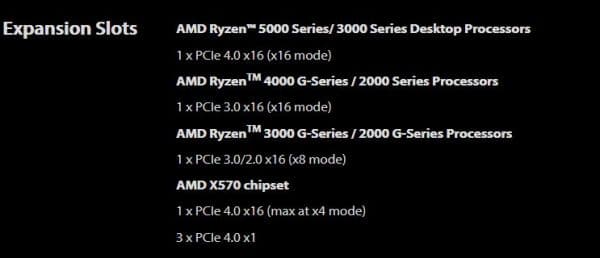
The specs above show that the x16 slot on this motherboard will work at PCIe v4.o only if the AMD Ryzen processor is from the newer 5000 and 3000 series.
For the 4000G, 2000, and 2000G series Ryzen processors, the same slot will work at v3.0.
Also Read:
- What Are PCIe Lanes? – Beginners Guide
- Can I Use a PCIe 3.0 Card in a 2.0 Slot?
- 10 Things That Can Be Plugged in PCIe Slots
How to Check PCI Express Slot Version?
There are four simple ways that you can use to check the PCI Express version of the slot:
- Use a Free Third-Party Software like GPU-Z
- Manually Check the Motherboard
- Check the Specsheet Online
- Use the Provided User Guide/Manual
1. Use a Free Third Party Software
This is ideal for checking most users’ PCI Express slot versions. It will provide a lot of information even for those not used to digging into their computers for information.
Different applications offer this service, and most do it at no cost to the user.
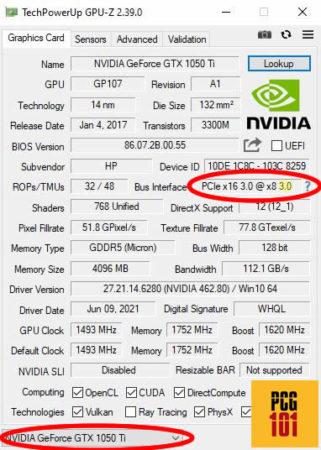
GPU-Z is a profiling tool that you can use to get information about the graphics card on your system. In addition to a plethora of helpful information, it highlights the PCIe slot and the version of the slot the graphics card is connected to.
The software is free to download.
Once installed, you must run it and let it collect the necessary data. It will then open a window that shows you various tabs, indicating the different subsections into which the collected information is organized.
You will need to find the Graphics Card tab at the top. This will contain various information about your GPU. You are looking for the field marked as “Bus Interface.”
Here you will see information about your PCIe connection. It will give you data about the PCIe version and its transfer rate, which will paint a good picture of your PCIe slot version.
Ensure you have the right graphics card selected from the drop-down menu at the bottom left of the window.
This software is not to be confused with CPU-Z, which is an excellent tool for discovering various aspects of the rest of the components on your system.
Drawback
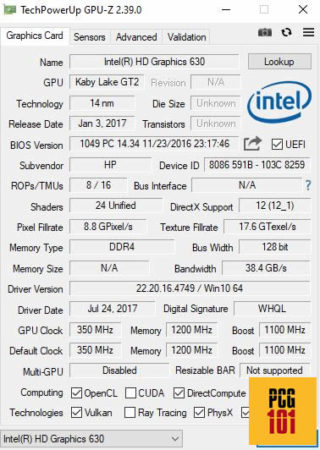
While this method works great if you have a dedicated graphics card installed, this utility does not work correctly if you only have an integrated graphics card.
As seen above, the utility could not read the Bus Interface when selecting the Integrated GPU. This is because the integrated GPU is found within the CPU. It is not connected to the PCIe interface.
Also Read: Which Intel and AMD CPUs Support PCIe 4.0?
2. Manually Checking the Motherboard
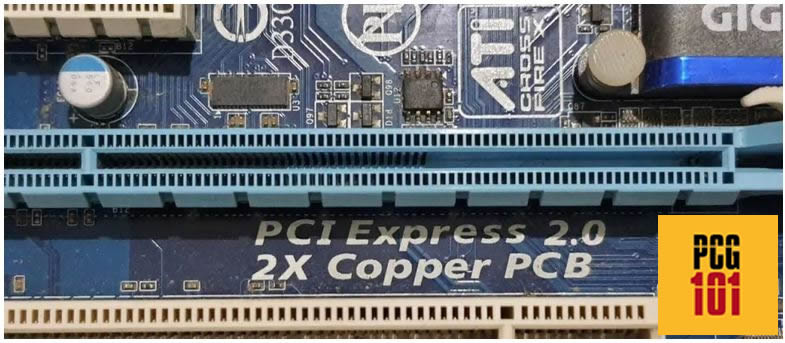
This method can be tricky for most users, particularly those without the technical expertise to open their PCs.
Many manufacturers use labels extensively for the different components on the motherboard.
Often, the label for the PCIe version your motherboard conforms to can be located on the motherboard itself.
So basically, what you need to do is open up your PC and take a peek at the motherboard. If you have a transparent side panel, you may even do this without necessarily opening it up – as long as your view isn’t obstructed.
Demerits
This method may confuse some users since some motherboards have a combination of PCIe slots adhering to different versions. Hence, one slot may operate at V4.0 while the other at V3.0 on the SAME motherboard.
For instance, the AMD B550 chipset motherboard, like the ASUS ROG Strix B550 Gaming, has the first PCIe x16 slot operating at V4.0 and the rest working at V3.0.
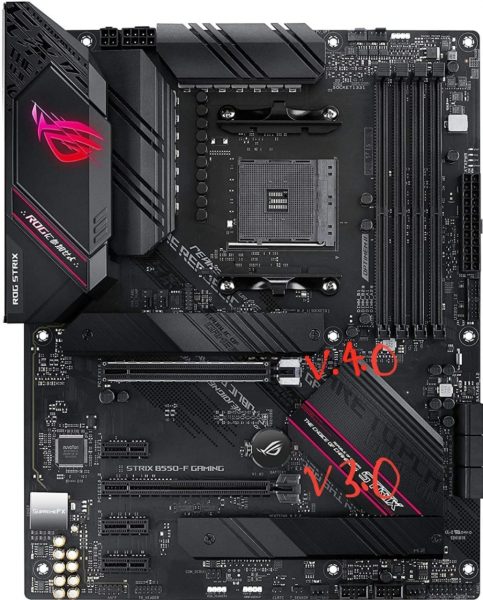
On top of that, some boards may not have any labeling for the PCIe version.
If that is the case with yours, then you can take this opportunity to find the board’s model number label, which can most certainly be found on it physically; you will need the model name of your board for the following method.
Also Read:
3. Checking with the Manufacturer – The Most Recommended Method
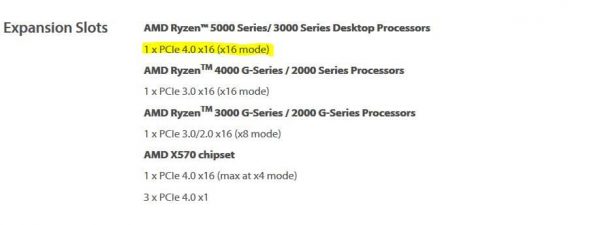
The best method, in my opinion, is to check the PCIe version by visiting the manufacturer’s website, as this gives you the most comprehensive details regarding the PCIe version of the slots on your motherboard.
You will need to know the make and model of your motherboard.
As mentioned above, you can find the make and model by physically checking the motherboard for the model number label or accessing System Information (type msinfo64.exe in the Search Bar after pressing the Windows button).
With the model number in hand, finding your board on the manufacturer’s product page should be pretty straightforward. Just Google the model number and visit your board’s relevant spec sheet page.
You will find detailed information about the PCIe slots and the version every slot conforms to. You will also get to know their generation along with other important information.
4. User Guide / Technical Manual
You will likely get a user’s guide in the packaging if it’s a new motherboard.
This document will contain important information about your motherboard, and you may even find information about the version of the PCI Express slots available.
Of course, if you have misplaced the manual, as most users do, and you do not recall the make and model of your motherboard, then you will have to follow other methods highlighted above.
Also Read: How to Check How Many PCIe Slots I Have
Video Tutorial
This video tutorial identifies the PCIe version of the slot and the motherboard.
Conclusion
Before installing new expansion cards on a motherboard, checking the PCI Express slot version is crucial to ensure everything is compatible.
There are many ways to do this, and the amount of information you get regarding the PCIe slot and its version depends on your chosen method.
That said, you can use third-party applications to get information about PCIe versions on your computer.
You may even do it yourself by opening your PC and checking for any labeling on the board.
However, the most recommended option by far is to check the official spec sheet for your board.
All in all, getting this information shouldn’t be much of a hassle.
Also Read: Which Motherboards Support PCIe 4.0?
frequently asked questions
1. Can I upgrade my computer’s PCI Express slot to a newer version?
No, it is not possible to upgrade the PCI Express slot of a computer.
The slot is built into the motherboard, and upgrading it would require replacing the entire motherboard, which is not practical in most cases.
However, you can upgrade the components that use the PCI Express slot, such as the graphics card, to a newer version if your motherboard supports it.
2. What should I do if my computer does not have a PCI Express slot or has an outdated version?
If your computer does not have a PCI Express slot or has an outdated version, your options for upgrading the graphics card or other components that require a PCI Express slot may be limited.
You can try using an external graphics card enclosure that connects to your computer’s USB or Thunderbolt port, but this may not be as powerful as an internal graphics card.
Alternatively, you may need to consider upgrading to a newer computer or motherboard that supports the latest PCI Express version.
3. Are there any compatibility issues to consider when upgrading to a newer PCI Express version?
Yes, there are several compatibility issues to consider when upgrading to a newer PCI Express version.
First, you need to ensure that your motherboard supports the newer version of PCI Express.
Second, you need to ensure that the component you want to install, such as a graphics card, is compatible with the new PCI Express version.
Third, you need to consider whether your power supply unit can handle the power requirements of the new component.
Finally, you should also check if there are any software or driver updates required to use the new component with your computer.
